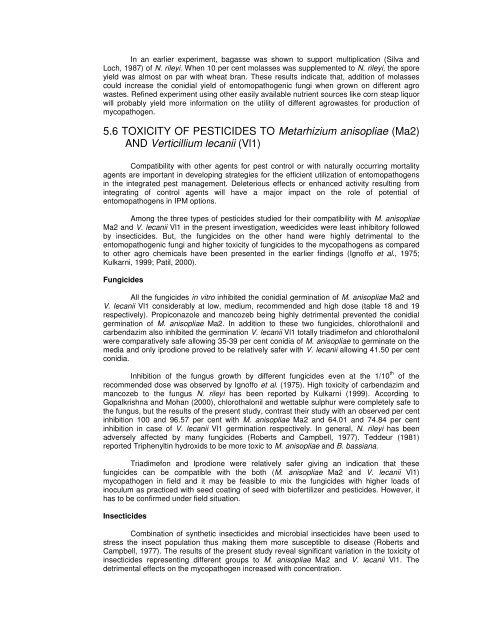ISOLATION AND CHARACTERIZATION OF ENTOMOPATHOGENIC ...
ISOLATION AND CHARACTERIZATION OF ENTOMOPATHOGENIC ...
ISOLATION AND CHARACTERIZATION OF ENTOMOPATHOGENIC ...
You also want an ePaper? Increase the reach of your titles
YUMPU automatically turns print PDFs into web optimized ePapers that Google loves.
In an earlier experiment, bagasse was shown to support multiplication (Silva and<br />
Loch, 1987) of N. rileyi. When 10 per cent molasses was supplemented to N. rileyi, the spore<br />
yield was almost on par with wheat bran. These results indicate that, addition of molasses<br />
could increase the conidial yield of entomopathogenic fungi when grown on different agro<br />
wastes. Refined experiment using other easily available nutrient sources like corn steap liquor<br />
will probably yield more information on the utility of different agrowastes for production of<br />
mycopathogen.<br />
5.6 TOXICITY <strong>OF</strong> PESTICIDES TO Metarhizium anisopliae (Ma2)<br />
<strong>AND</strong> Verticillium lecanii (Vl1)<br />
Compatibility with other agents for pest control or with naturally occurring mortality<br />
agents are important in developing strategies for the efficient utilization of entomopathogens<br />
in the integrated pest management. Deleterious effects or enhanced activity resulting from<br />
integrating of control agents will have a major impact on the role of potential of<br />
entomopathogens in IPM options.<br />
Among the three types of pesticides studied for their compatibility with M. anisopliae<br />
Ma2 and V. lecanii Vl1 in the present investigation, weedicides were least inhibitory followed<br />
by insecticides. But, the fungicides on the other hand were highly detrimental to the<br />
entomopathogenic fungi and higher toxicity of fungicides to the mycopathogens as compared<br />
to other agro chemicals have been presented in the earlier findings (Ignoffo et al., 1975;<br />
Kulkarni, 1999; Patil, 2000).<br />
Fungicides<br />
All the fungicides in vitro inhibited the conidial germination of M. anisopliae Ma2 and<br />
V. lecanii Vl1 considerably at low, medium, recommended and high dose (table 18 and 19<br />
respectively). Propiconazole and mancozeb being highly detrimental prevented the conidial<br />
germination of M. anisopliae Ma2. In addition to these two fungicides, chlorothalonil and<br />
carbendazim also inhibited the germination V. lecanii Vl1 totally triadimefon and chlorothalonil<br />
were comparatively safe allowing 35-39 per cent conidia of M. anisopliae to germinate on the<br />
media and only iprodione proved to be relatively safer with V. lecanii allowing 41.50 per cent<br />
conidia.<br />
Inhibition of the fungus growth by different fungicides even at the 1/10 th of the<br />
recommended dose was observed by Ignoffo et al. (1975). High toxicity of carbendazim and<br />
mancozeb to the fungus N. rileyi has been reported by Kulkarni (1999). According to<br />
Gopalkrishna and Mohan (2000), chlorothalonil and wettable sulphur were completely safe to<br />
the fungus, but the results of the present study, contrast their study with an observed per cent<br />
inhibition 100 and 96.57 per cent with M. anisopliae Ma2 and 64.01 and 74.84 per cent<br />
inhibition in case of V. lecanii Vl1 germination respectively. In general, N. rileyi has been<br />
adversely affected by many fungicides (Roberts and Campbell, 1977). Teddeur (1981)<br />
reported Triphenyltin hydroxids to be more toxic to M. anisopliae and B. bassiana.<br />
Triadimefon and Iprodione were relatively safer giving an indication that these<br />
fungicides can be compatible with the both (M. anisopliae Ma2 and V. lecanii Vl1)<br />
mycopathogen in field and it may be feasible to mix the fungicides with higher loads of<br />
inoculum as practiced with seed coating of seed with biofertilizer and pesticides. However, it<br />
has to be confirmed under field situation.<br />
Insecticides<br />
Combination of synthetic insecticides and microbial insecticides have been used to<br />
stress the insect population thus making them more susceptible to disease (Roberts and<br />
Campbell, 1977). The results of the present study reveal significant variation in the toxicity of<br />
insecticides representing different groups to M. anisopliae Ma2 and V. lecanii Vl1. The<br />
detrimental effects on the mycopathogen increased with concentration.
















